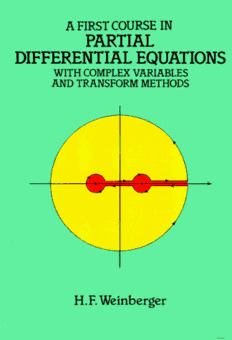
A First Course in Partial Differential Equations: with Complex Variables and Transform Methods (Dover Books on Mathematics) PDF
456 Pages·1995·13.433 MB·English
Most books are stored in the elastic cloud where traffic is expensive. For this reason, we have a limit on daily download.
Preview A First Course in Partial Differential Equations: with Complex Variables and Transform Methods (Dover Books on Mathematics)
Description:
I got this book after finishing Farlow's Partial Differential Equations for Scientists and Engineers. This is a much more mathematically rigorous and sophisticated book, and it took me a lot longer to go through it. (I still haven't done the last two sections on the Laplace transform and approximation methods). My original goal was to learn complex analysis, and since Farlow recommended this book for that topic, I started in the middle with Section VIII, Analytic Functions of a Complex Variable, then did IX and X, then I through VII. This caused a few difficulties solving some of the problems in the later sections due to unfamiliarity with material presented in the earlier sections. E.g. problem 71.4 presumes a knowledge of Green's function, which is covered in section V. Nonetheless, this worked out OK. I now feel as though I have a pretty solid grounding in the material (by which I mean not that I can remember it all, but I can recognize when I've seen it before, and know where to look it up again). That is my operational definition of having "learned" the material.
Frankly, I'm quite surprised by the second reviewer's comment that this book would not be good for self-instruction. I thought it was great! But I had to be very patient and resist the urge to move ahead before I really understood what I had just read. Doing the problems is an excellent reality check! That's one of the features of this book that I liked the most: lots of problems, with ALL the answers in the back, so you can't fool yourself. Most of the answers can be reached with persistence, although I was stumped by a few. But don't buy this book if you don't have a background in calculus and ordinary differential equations! It would also be helpful to review the topic of partial differential equations in an easier format, like Farlow, before progressing to this text.
The material is interesting and varied. There are sections heavy on abstract math and proofs of theorems, other sections mostly practical in orientation. The section on complex analysis lives up to its billing in Farlow. In general, I found that I could skim through the really abstract material without losing the thread of the argument. I'm not good at proofs so I skipped over most of the problems that called for proving something. But at least now I know what is meant by existence and uniqueness proofs, etc.
The book has very few errors. I've listed the ones I think are errors below. Maybe they are and maybe they aren't!
p. 182 second paragraph R(r) sin(n*theta) etc. should be R(r) sin(m*theta) etc.
p. 192 fifth line from bottom "degree n in x,y, and z" should be "degree n in x,y, and r".
p. 223 second equation from bottom should be du2/de*du1/dx - dv2/de*dv1/dx + i(dv2/de*du1/dx + du2/de*dv1/dx)
p. 265 last equation right hand side integrand should be e^(-i*theta), not e^(i*theta).
Solutions to exercises:
1.4: rho subzero du1/dx + d rho subone/dt = 0
5.4: answer can be reduced further to 157/4096, which is how my calculator displayed it
7.5: last line: dA/dt greater than or equal to 0
10.2: second line: epsilon 3 = z*sqrt(alpha/D)
14.1e: e^(-n^2*pi^2*t-t-x)*sin(n*pi*(x-1))
18.4: right side of equation should be 1/2 (e^pi + e^(-pi)) i.e. cosh(pi)
31.4: one times first sum, not two times first sum, and difference between first sum and second (double) sum, not sum of the two
32.3: second line, numerator, sinh term should be sinh (sqrt((n-1/2)^2 + (2m-1)^2 +1) * (1-z))
37.1: substituting xbar = x+1 in formula for c sub-n I get c sub-n twice what answer gives.
37.4: formula for c sub-n: integrand should include (1+x)^-1, not ^-2.
44.4: the exponential t-term is e^(-(mu sub-k supra-(n+1/2))*t), not e^(-mu sub-k supra-((n+1/2)*t))
50.7: log term is log(2 plus or minus sqrt(3))
53.4: the part of the disk to the LEFT of the line....
58.2: ? pi*i*(e-2)
58.7: ? -pi/3
Happy self-instructing!
See more
The list of books you might like
Most books are stored in the elastic cloud where traffic is expensive. For this reason, we have a limit on daily download.
